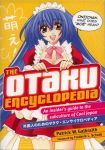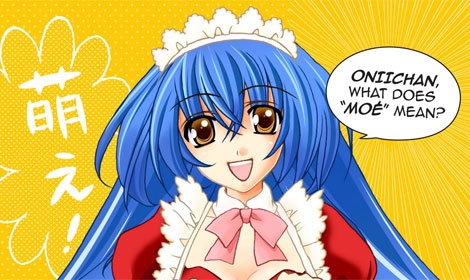Who here is sick and tired of reading about Akira, Ghost in the Shell, and Neon Genesis Evangelion in academic or fan literature? I certainly am, there's a world after Eva, and there are things in Japanese culture that can be appreciated that don't have ninjas. Well, for those of you who don't know what moe is, or have no idea what shokushu-kei is, there is The Otaku Encyclopedia by Patrick Galbraith (the guy with the DBZ hair, you might have seen him before on various websites.
In all seriousness, the book is astounding. The pages are filled with color, insight, and some very minor details about otaku culture. Even the most elitist of otaku would find themselves reading an entry that they had not known the exact root of. The book offers a thorough representation of the culture aimed for anyone: from beginners to experts. What's more interesting are the interviews interspersed throughout the book, and countless color-pages of examples and illustrated aids.
 Galbraith is an otaku who lived through an age where it wasn’t cool to be one. Being a blatant one in his younger years as an exchange student from Alaska, his self-professed otaku-dom led him to getting kicked out of otaku-hating households around Tokyo. His interests didn’t keep him away from Japan though, and he returned to Japan in 2006, only to find the hatred towards the culture he idealized had been turned upside down once again for him. With being a nerd suddenly cool in Japan, Galbraith studies and documents the history of otaku and their "holy-land," Akihabara as a scholar at the prestigious University of Tokyo.
Galbraith is an otaku who lived through an age where it wasn’t cool to be one. Being a blatant one in his younger years as an exchange student from Alaska, his self-professed otaku-dom led him to getting kicked out of otaku-hating households around Tokyo. His interests didn’t keep him away from Japan though, and he returned to Japan in 2006, only to find the hatred towards the culture he idealized had been turned upside down once again for him. With being a nerd suddenly cool in Japan, Galbraith studies and documents the history of otaku and their "holy-land," Akihabara as a scholar at the prestigious University of Tokyo.
He used his love for the sub-culture and wrote this compendium on otaku culture. His knowledge of the history goes well beyond the extent of what many people see as otaku culture today – reaching as far back as Buddhist-era medieval Japan. Interspersed in all of this is also proof that he is as much a part of this culture as its scribe, evidenced by his use of his very own photos on some of the example photos – one photo shows him happily making heart shapes with his hands with a maid. What could be the most important part of this book, however, is the collection of interviews Galbraith did to find an overarching theme in otaku culture. The entourage of celebrity otaku names in the roster interspersed throughout the book is great. Anime director Yamamoto Yutaka of Haruhi, Kannagi, and, the upcoming, Tonari no 801-chan fame; Director of Comic Market, Ichikawa Koichi; and idol extraordinaire, Shoko-tan make an appearance as a guest of Galbraith. These interviews explore the nature of Japanese Otaku-dom from its roots to contemporary issues. In Okada Toshio's interview, Galbraith explores the root of otaku culture from its early days, and tries to define the exact meaning of otaku. What I greatly enjoyed was Yamamoto Yutaka's criticism of modern day otaku in which he describes them as rude and selfish, that most otaku are lazy and unmotivated to reach beyond their own entertainment needs in anime.
What could be the most important part of this book, however, is the collection of interviews Galbraith did to find an overarching theme in otaku culture. The entourage of celebrity otaku names in the roster interspersed throughout the book is great. Anime director Yamamoto Yutaka of Haruhi, Kannagi, and, the upcoming, Tonari no 801-chan fame; Director of Comic Market, Ichikawa Koichi; and idol extraordinaire, Shoko-tan make an appearance as a guest of Galbraith. These interviews explore the nature of Japanese Otaku-dom from its roots to contemporary issues. In Okada Toshio's interview, Galbraith explores the root of otaku culture from its early days, and tries to define the exact meaning of otaku. What I greatly enjoyed was Yamamoto Yutaka's criticism of modern day otaku in which he describes them as rude and selfish, that most otaku are lazy and unmotivated to reach beyond their own entertainment needs in anime.
As for the actual encyclopedic entries, Otaku gives the reader an easy way to navigate the book. The entries are in alphabetical-order, but some entries also offer related terms to look up for further information. This way, the book is easily navigated for specific entries, but also very good for skimming through to pick up random tidbits of information. The book appeals to all fans. The beginners, or people that don't quite understand the culture will get a good handle of the nature of the culture just by skimming through the colorful entries.
On a deeper level of appreciation, Galbraith goes beyond the Pocky eating, sake-bomb guzzling stereotype of otaku culture. The book also explores the dark side of the society; while the book is an "encyclopedia," the book serves as a critique of the current state of the otaku culture at the same time. Galbraith describes his own ostracizing experience by his home stay hosts from being an otaku in the introduction. Schodt, in his foreword, describes the intricate and complex connotations otaku have begun to take hold on Japanese culture. The interviews serve to show a whole spectrum of what the otaku culture is about. Most specifically, it explores what an otaku is to these people who are considered the "biggest" in otaku. Surprisingly, some of them have answered that they never really thought of themselves as otaku, nor were even sure from the beginning what that really meant.
Another feature worthy of note is the international nature of the book. While otaku is not confined to anime and manga, the book thoroughly covers the fan cultures of foreign nations. Trekkies, Anime Expo, and Walt Disney also make an appearance and each entry has a well thought out connection with how they are important in context to Japan and the "otaku" of today both in and outside Japan.
I do have a few complaints on the book, however. Galbraith lacks some insight on what information to place in some entries. If he knows well enough to give spoiler warnings to readers on Mobile Suit Gundam and Evangelion, he should know that those entries should be reduced. I realize Evangelion is an important part of anime culture everywhere, but two full pages of description and synopsis is too much. The book covers a few other anime through its own entries, such as Akira and Ghost in the Shell, but not to the same extent. Gainax also takes another two pages by itself, and an interview with one of its founders and former "King of Otaku" Okada Toshio also graces the pages, perhaps a bit overboard on Gainax.
On the other hand, however, there was a lack of discussion on video gaming. It goes without saying, that the Japanese video gaming community is one of the largest and oldest in the world, next the United States'. Galbraith discounts much of this facet of otaku culture. While gamer Anno Haruna and Nintendo are mentioned, there is an absence of Sony, Sega, Square Enix, and all the other big names in popular gaming culture. While otaku culture, may be focused on anime and manga, the book does a poor job to address the running parallels with otaku culture with the video gaming industry.
A big argument made by Okada the Otaking was that otaku are now dead because they do not wish to create anymore; the same can be heard from Yamamoto's criticisms. Galbraith seems to hint that the new generation of otaku are fed a watered down product engineered for profit and lacking in creative drive. These arguments may seem sound at a glance as otaku culture spreads and the consumers outpace the creative drive, but the drive is not completely lost.
In what could be the biggest mistake, Galbraith completely discounts the doujinshi scene in Japan. While Comiket and Comitia are mentioned and their sale of doujinshi is distinguished from each other (Comiket sells fan works, Comitia sells original works), the "original works" are hardly mentioned. To say, Galbraith did not mention anything at all about the Touhou fandom, danmaku, doujin-soft, or anything about the nature of privately developed and distributed games.
While the reason may be because Galbraith wanted to focus on anime and manga, considering how pervasive Touhou has become to otaku culture, it is strange that there is no mention of it. From front to back, nothing about it can be found. From bullet-hell to Zun, I scoured the pages trying to find a mention of something related to Touhou but to no avail. No mention of Yukkuri or the musical remixes done by IOSYS and their associated flash animations. This is something that should not have been overlooked in otaku culture.
 Besides that, The Otaku Encyclopedia serves a great springboard into the world of Anime. While, the lack of Touhou and gaming is truly disheartening, I have no other major complaints. The book is beautifully done, and is definitely worth taking a look. The academic, otaku, and the curious will all find this book an essential guide.
Besides that, The Otaku Encyclopedia serves a great springboard into the world of Anime. While, the lack of Touhou and gaming is truly disheartening, I have no other major complaints. The book is beautifully done, and is definitely worth taking a look. The academic, otaku, and the curious will all find this book an essential guide.
(Photo of Yutaka Yamamoto courtesy of Otakon)

